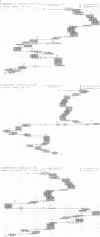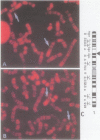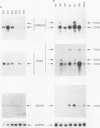Abstract
AIMS: To characterise the human cyr61 gene (cyr61H) and determine its chromosomal locality. To compare expression of cyr61H in human tumour cell lines with that of two other structurally related genes, novH (nephroblastoma overexpressed gene) and CTGF (connective tissue growth factor), that are likely to play a role in the control of cell proliferation and differentiation. METHODS: To isolate the human cyr61 gene, placental genomic and HeLa cDNA libraries were screened with murine cyr61 cDNA. The nucleotide sequence of the complete cyr61H cDNA was established. Both Southern blotting of a panel of somatic cell hybrids and in situ hybridisation on chromosomes were performed to map the cyr61H gene. Expression of cyr61H, novH, CTGF, and novH was analysed by northern blotting in both human neuroblastomas and glioblastoma cell lines. RESULTS: Genomic and cDNA clones encompassing the cyr61H gene were isolated and characterised. Comparison of mouse and human cyr61 sequences indicated that their genomic organisation is highly conserved. Alignment of coding sequences highlighted the conservation of cyr61 regions that might be critical for its biological function. The data showed that the cyr61H gene is assigned to chromosome 1p22.3 and that different levels of cyr61H, CTGF, and novH mRNA have been detected in several human tumour cell lines derived from the nervous system. CONCLUSIONS: The human cyr61 gene belongs to an emerging family of genes including CTGF/fisp12 and nov. The murine cyr61 encodes an extracellular cysteine rich protein that exhibits chemotactic activity, promotes attachment and spreading of cells, and potentiates the mitogenic effect of growth factors. Assignment of the cyr61H gene to chromosome 1p22.3 will allow studies to determine whether human pathologies derived from the nervous system or from other tissues are associated with chromosomal abnormalities involving this region. Although the coding regions of cyr61H, CTGF, and novH are highly homologous, a growing body of evidence suggests that expression of these genes is regulated differentially, and that a balance between expression of these genes might represent a key element in determining the stage of differentiation and/or the malignant potential of tumour cells.
Full text
PDF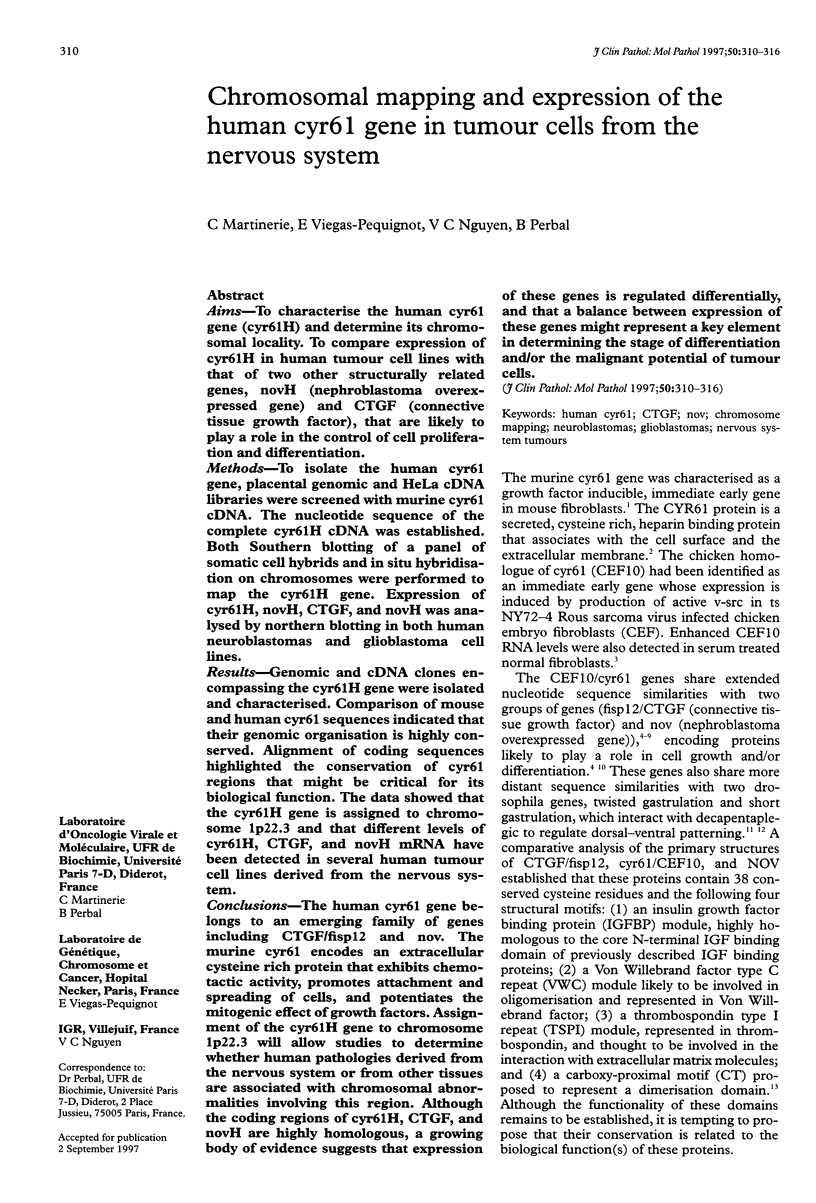

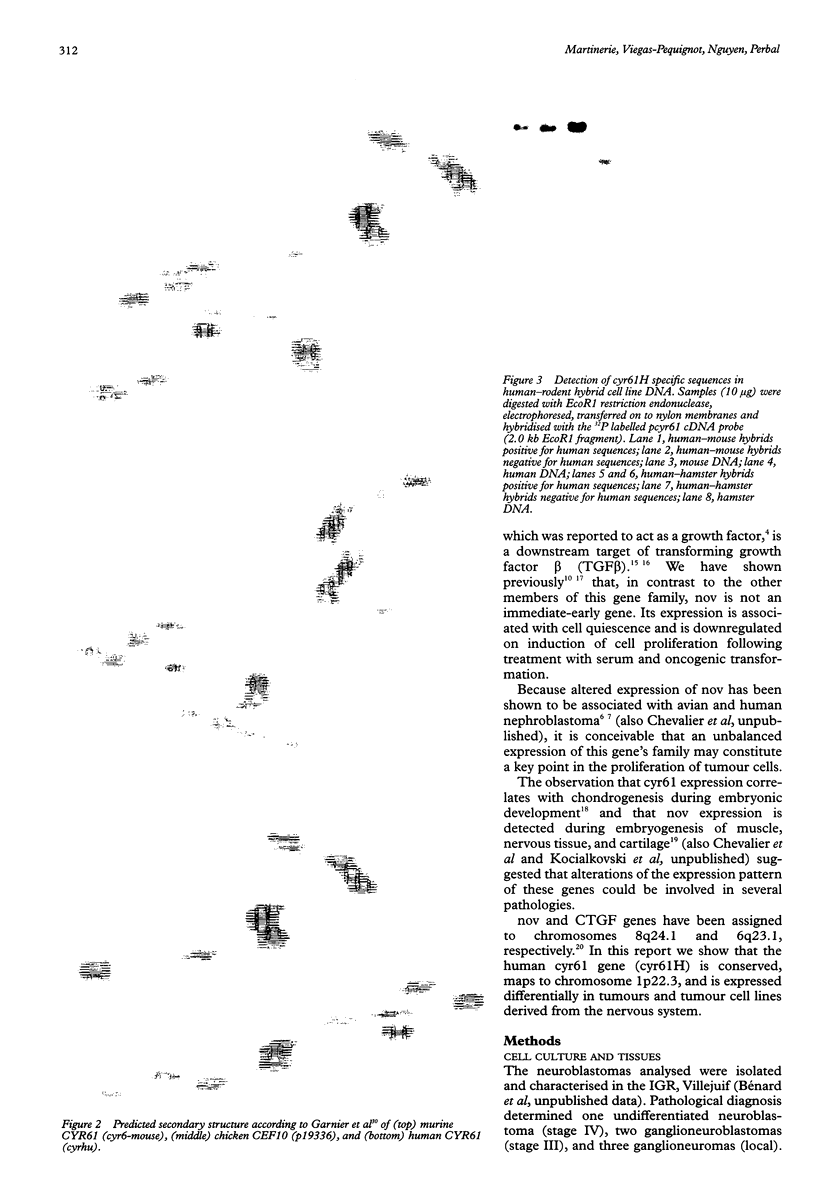
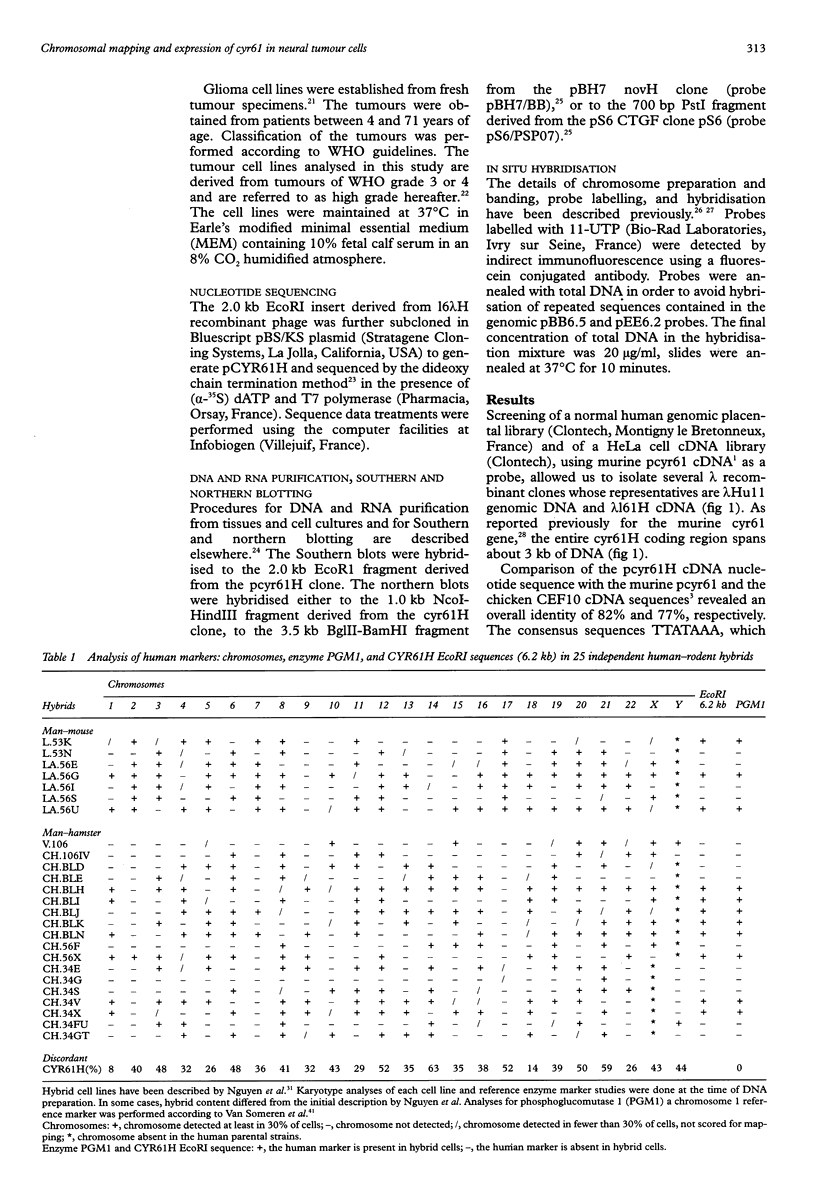
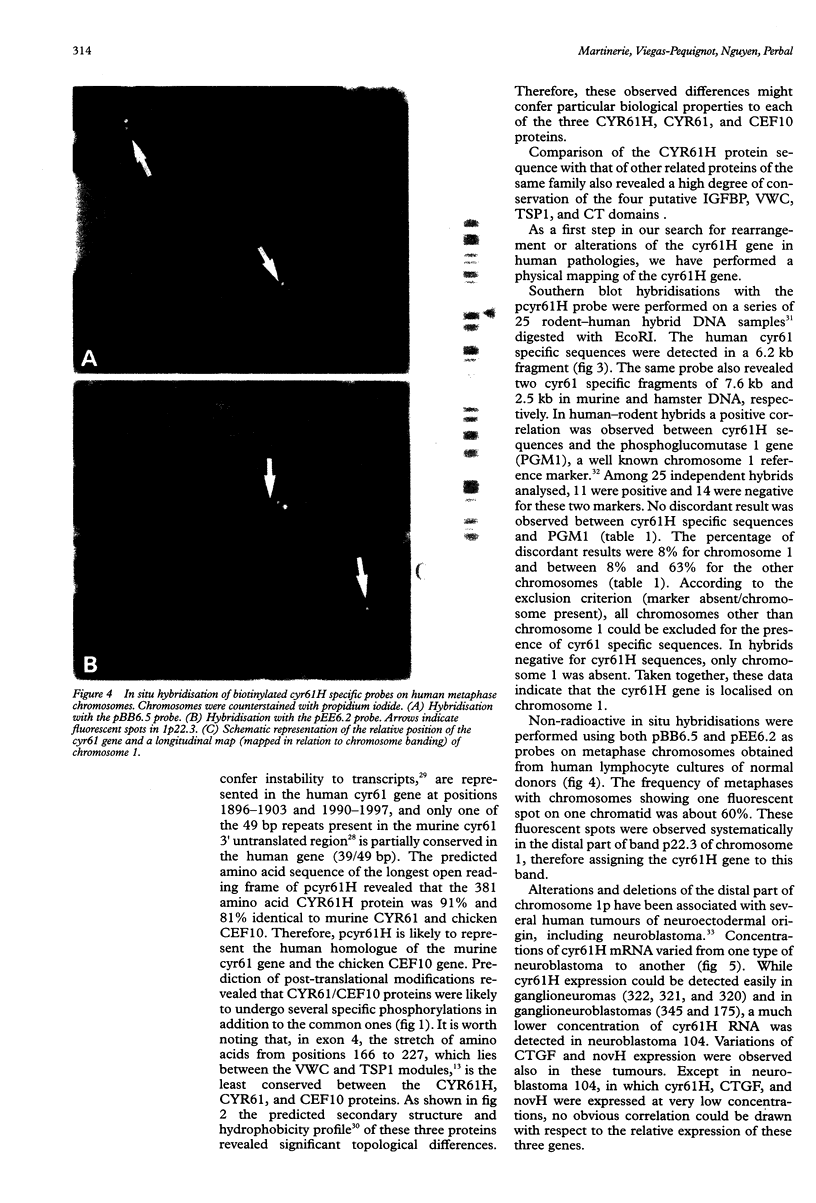
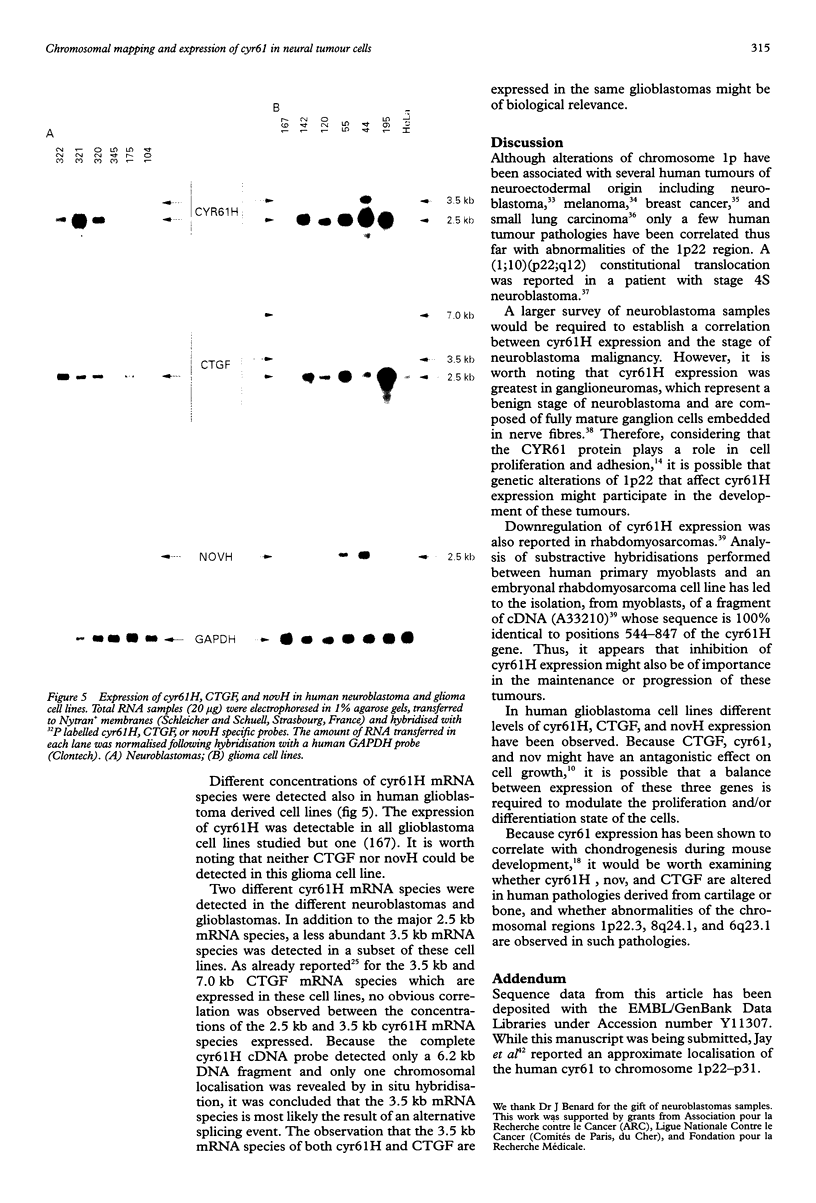
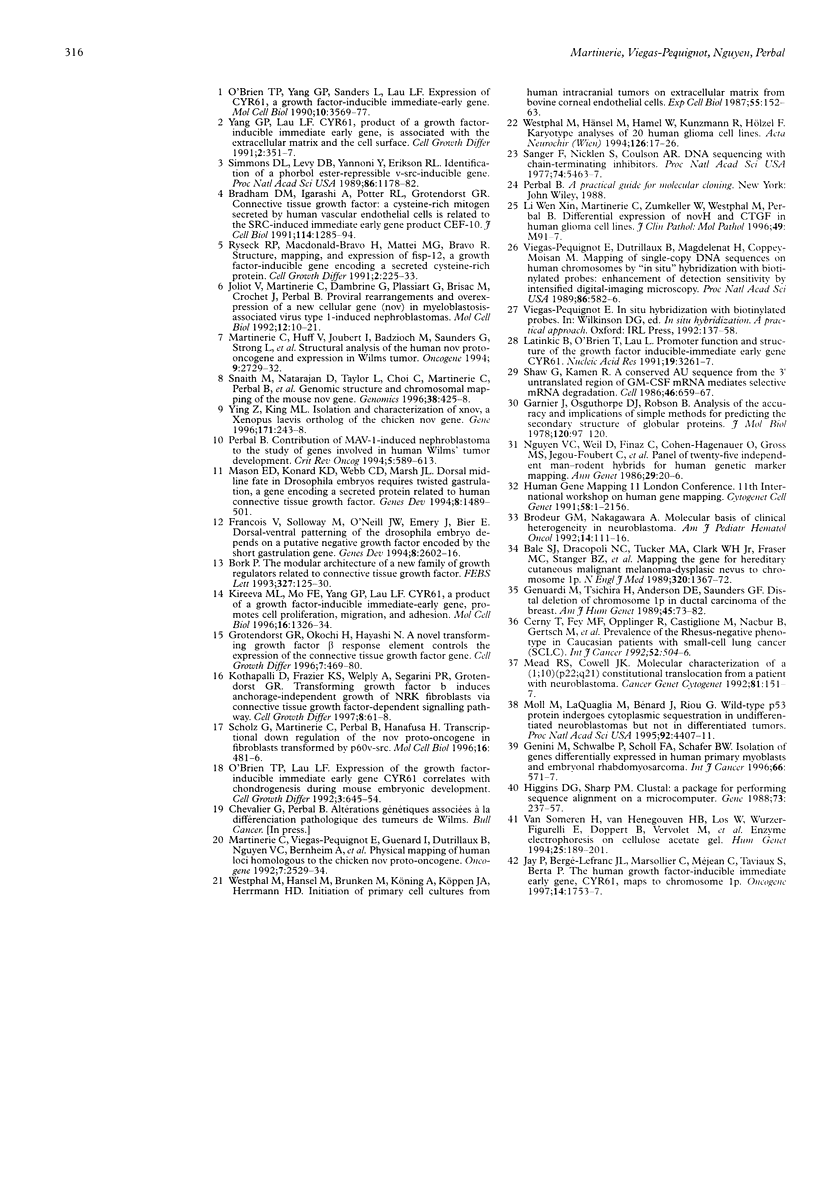
Images in this article
Selected References
These references are in PubMed. This may not be the complete list of references from this article.
- Bale S. J., Dracopoli N. C., Tucker M. A., Clark W. H., Jr, Fraser M. C., Stanger B. Z., Green P., Donis-Keller H., Housman D. E., Greene M. H. Mapping the gene for hereditary cutaneous malignant melanoma-dysplastic nevus to chromosome 1p. N Engl J Med. 1989 May 25;320(21):1367–1372. doi: 10.1056/NEJM198905253202102. [DOI] [PubMed] [Google Scholar]
- Bork P. The modular architecture of a new family of growth regulators related to connective tissue growth factor. FEBS Lett. 1993 Jul 26;327(2):125–130. doi: 10.1016/0014-5793(93)80155-n. [DOI] [PubMed] [Google Scholar]
- Bradham D. M., Igarashi A., Potter R. L., Grotendorst G. R. Connective tissue growth factor: a cysteine-rich mitogen secreted by human vascular endothelial cells is related to the SRC-induced immediate early gene product CEF-10. J Cell Biol. 1991 Sep;114(6):1285–1294. doi: 10.1083/jcb.114.6.1285. [DOI] [PMC free article] [PubMed] [Google Scholar]
- Brodeur G. M., Nakagawara A. Molecular basis of clinical heterogeneity in neuroblastoma. Am J Pediatr Hematol Oncol. 1992 May;14(2):111–116. doi: 10.1097/00043426-199205000-00004. [DOI] [PubMed] [Google Scholar]
- Francois V., Solloway M., O'Neill J. W., Emery J., Bier E. Dorsal-ventral patterning of the Drosophila embryo depends on a putative negative growth factor encoded by the short gastrulation gene. Genes Dev. 1994 Nov 1;8(21):2602–2616. doi: 10.1101/gad.8.21.2602. [DOI] [PubMed] [Google Scholar]
- Garnier J., Osguthorpe D. J., Robson B. Analysis of the accuracy and implications of simple methods for predicting the secondary structure of globular proteins. J Mol Biol. 1978 Mar 25;120(1):97–120. doi: 10.1016/0022-2836(78)90297-8. [DOI] [PubMed] [Google Scholar]
- Genuardi M., Tsihira H., Anderson D. E., Saunders G. F. Distal deletion of chromosome Ip in ductal carcinoma of the breast. Am J Hum Genet. 1989 Jul;45(1):73–82. [PMC free article] [PubMed] [Google Scholar]
- Grotendorst G. R., Okochi H., Hayashi N. A novel transforming growth factor beta response element controls the expression of the connective tissue growth factor gene. Cell Growth Differ. 1996 Apr;7(4):469–480. [PubMed] [Google Scholar]
- Jay P., Bergé-Lefranc J. L., Marsollier C., Méjean C., Taviaux S., Berta P. The human growth factor-inducible immediate early gene, CYR61, maps to chromosome 1p. Oncogene. 1997 Apr 10;14(14):1753–1757. doi: 10.1038/sj.onc.1200986. [DOI] [PubMed] [Google Scholar]
- Joliot V., Martinerie C., Dambrine G., Plassiart G., Brisac M., Crochet J., Perbal B. Proviral rearrangements and overexpression of a new cellular gene (nov) in myeloblastosis-associated virus type 1-induced nephroblastomas. Mol Cell Biol. 1992 Jan;12(1):10–21. doi: 10.1128/mcb.12.1.10. [DOI] [PMC free article] [PubMed] [Google Scholar]
- Kireeva M. L., MO F. E., Yang G. P., Lau L. F. Cyr61, a product of a growth factor-inducible immediate-early gene, promotes cell proliferation, migration, and adhesion. Mol Cell Biol. 1996 Apr;16(4):1326–1334. doi: 10.1128/mcb.16.4.1326. [DOI] [PMC free article] [PubMed] [Google Scholar]
- Kothapalli D., Frazier K. S., Welply A., Segarini P. R., Grotendorst G. R. Transforming growth factor beta induces anchorage-independent growth of NRK fibroblasts via a connective tissue growth factor-dependent signaling pathway. Cell Growth Differ. 1997 Jan;8(1):61–68. [PubMed] [Google Scholar]
- Latinkic B. V., O'Brien T. P., Lau L. F. Promoter function and structure of the growth factor-inducible immediate early gene cyr61. Nucleic Acids Res. 1991 Jun 25;19(12):3261–3267. doi: 10.1093/nar/19.12.3261. [DOI] [PMC free article] [PubMed] [Google Scholar]
- Martinerie C., Huff V., Joubert I., Badzioch M., Saunders G., Strong L., Perbal B. Structural analysis of the human nov proto-oncogene and expression in Wilms tumor. Oncogene. 1994 Sep;9(9):2729–2732. [PubMed] [Google Scholar]
- Martinerie C., Viegas-Pequignot E., Guenard I., Dutrillaux B., Nguyen V. C., Bernheim A., Perbal B. Physical mapping of human loci homologous to the chicken nov proto-oncogene. Oncogene. 1992 Dec;7(12):2529–2534. [PubMed] [Google Scholar]
- Mason E. D., Konrad K. D., Webb C. D., Marsh J. L. Dorsal midline fate in Drosophila embryos requires twisted gastrulation, a gene encoding a secreted protein related to human connective tissue growth factor. Genes Dev. 1994 Jul 1;8(13):1489–1501. doi: 10.1101/gad.8.13.1489. [DOI] [PubMed] [Google Scholar]
- Moll U. M., LaQuaglia M., Bénard J., Riou G. Wild-type p53 protein undergoes cytoplasmic sequestration in undifferentiated neuroblastomas but not in differentiated tumors. Proc Natl Acad Sci U S A. 1995 May 9;92(10):4407–4411. doi: 10.1073/pnas.92.10.4407. [DOI] [PMC free article] [PubMed] [Google Scholar]
- O'Brien T. P., Lau L. F. Expression of the growth factor-inducible immediate early gene cyr61 correlates with chondrogenesis during mouse embryonic development. Cell Growth Differ. 1992 Sep;3(9):645–654. [PubMed] [Google Scholar]
- O'Brien T. P., Yang G. P., Sanders L., Lau L. F. Expression of cyr61, a growth factor-inducible immediate-early gene. Mol Cell Biol. 1990 Jul;10(7):3569–3577. doi: 10.1128/mcb.10.7.3569. [DOI] [PMC free article] [PubMed] [Google Scholar]
- Perbal B. Contribution of MAV-1-induced nephroblastoma to the study of genes involved in human Wilms' tumor development. Crit Rev Oncog. 1994;5(6):589–613. [PubMed] [Google Scholar]
- Ryseck R. P., Macdonald-Bravo H., Mattéi M. G., Bravo R. Structure, mapping, and expression of fisp-12, a growth factor-inducible gene encoding a secreted cysteine-rich protein. Cell Growth Differ. 1991 May;2(5):225–233. [PubMed] [Google Scholar]
- Sanger F., Nicklen S., Coulson A. R. DNA sequencing with chain-terminating inhibitors. Proc Natl Acad Sci U S A. 1977 Dec;74(12):5463–5467. doi: 10.1073/pnas.74.12.5463. [DOI] [PMC free article] [PubMed] [Google Scholar]
- Scholz G., Martinerie C., Perbal B., Hanafusa H. Transcriptional down regulation of the nov proto-oncogene in fibroblasts transformed by p60v-src. Mol Cell Biol. 1996 Feb;16(2):481–486. doi: 10.1128/mcb.16.2.481. [DOI] [PMC free article] [PubMed] [Google Scholar]
- Shaw G., Kamen R. A conserved AU sequence from the 3' untranslated region of GM-CSF mRNA mediates selective mRNA degradation. Cell. 1986 Aug 29;46(5):659–667. doi: 10.1016/0092-8674(86)90341-7. [DOI] [PubMed] [Google Scholar]
- Simmons D. L., Levy D. B., Yannoni Y., Erikson R. L. Identification of a phorbol ester-repressible v-src-inducible gene. Proc Natl Acad Sci U S A. 1989 Feb;86(4):1178–1182. doi: 10.1073/pnas.86.4.1178. [DOI] [PMC free article] [PubMed] [Google Scholar]
- Snaith M. R., Natarajan D., Taylor L. B., Choi C. P., Martinerie C., Perbal B., Schofield P. N., Boulter C. A. Genomic structure and chromosomal mapping of the mouse nov gene. Genomics. 1996 Dec 15;38(3):425–428. doi: 10.1006/geno.1996.0647. [DOI] [PubMed] [Google Scholar]
- Viegas-Pequignot E., Dutrillaux B., Magdelenat H., Coppey-Moisan M. Mapping of single-copy DNA sequences on human chromosomes by in situ hybridization with biotinylated probes: enhancement of detection sensitivity by intensified-fluorescence digital-imaging microscopy. Proc Natl Acad Sci U S A. 1989 Jan;86(2):582–586. doi: 10.1073/pnas.86.2.582. [DOI] [PMC free article] [PubMed] [Google Scholar]
- Westphal M., Hänsel M., Brunken M., König A., Köppen J. A., Herrmann H. D. Initiation of primary cell cultures from human intracranial tumors on extracellular matrix from bovine corneal endothelial cells. Exp Cell Biol. 1987;55(3):152–163. doi: 10.1159/000163411. [DOI] [PubMed] [Google Scholar]
- Westphal M., Hänsel M., Hamel W., Kunzmann R., Hölzel F. Karyotype analyses of 20 human glioma cell lines. Acta Neurochir (Wien) 1994;126(1):17–26. doi: 10.1007/BF01476489. [DOI] [PubMed] [Google Scholar]
- Yang G. P., Lau L. F. Cyr61, product of a growth factor-inducible immediate early gene, is associated with the extracellular matrix and the cell surface. Cell Growth Differ. 1991 Jul;2(7):351–357. [PubMed] [Google Scholar]
- Ying Z., King M. L. Isolation and characterization of xnov, a Xenopus laevis ortholog of the chicken nov gene. Gene. 1996 Jun 1;171(2):243–248. doi: 10.1016/0378-1119(95)00891-8. [DOI] [PubMed] [Google Scholar]
- van Someren H., Beijersbergen van Henegouwen H., Los W., Wurzer-Figurelli E., Doppert B., Vervloet M., Meera Khan P. Enzyme electrophoresis on cellulose acetate gel. II. Zymogram patterns in man-Chinese hamster somatic cell hybrids. Humangenetik. 1974;25(3):189–201. doi: 10.1007/BF00281426. [DOI] [PubMed] [Google Scholar]




